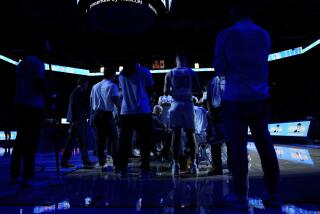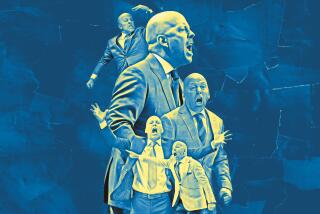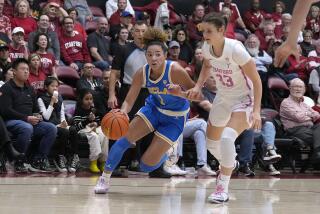Stanford Looks for Star Heals
After an early glimpse, it looks as if thereâs a chance Stanford, not Arizona, could be the best team in the West.
But itâs going to take some feet -- uh, feat -- for the Cardinal to win the Pacific 10 Conference.
Thatâs because Coach Mike Montgomeryâs sixth man might be the trainer, with the medical staff trying to hold off the threat of a stress fracture in forward Josh Childressâ left foot.
âItâs not serious unless it breaks. Weâre going to do everything we can to prevent that,â Montgomery said.
Stanford is also trying to finesse point guard Chris Hernandezâs sore back. He is playing with bulging disks a season after two stress fractures in his left foot reduced his season to a mere 18 minutes.
Yes, Arizona has tremendous young players. But Stanford has something the Wildcats donât -- two seniors in the starting lineup in forward Justin Davis and guard Matt Lottich. Stanford also has plenty of size and shooting ability and is playing with a dive-for-the-ball aggressiveness in the halfcourt.
The four-year run when Stanford finished in the top 10 every year is fading into history; the Cardinal has been No. 24 and No. 18 the last two seasons. But it looks as if this team has the potential to rise again.
âI think if I stay healthy and Josh takes care of his foot and doesnât make a mistake like I did and come back too early, I think weâll be one of the top teams in the nation,â Hernandez said. âI think we could get back to being like that No. 1 team we used to have three or four years ago. I definitely think we can get to that point.â
Childressâ foot is the first concern.
He is Stanfordâs leading returning scorer after averaging 14.1 points last season, and heâs the leading returning rebounder in the conference even though heâs only 6 feet 8.
âWeâre just erring on the side of caution,â Montgomery said. âIf you judge that itâs a stress problem, then youâre stupid to go on. It is not broken, but it could break. So it makes no sense to push it and have it break and then lose him for an extended period of time. We anticipate that in the next week or so the pain will go away.... When that happens, I think heâll be good to go.â
The number of stress injuries in the Stanford program sometimes seems too high to be coincidence. (Former player Curtis Borchardt is another who suffered repeated foot injuries.)
Last season, the San Jose Mercury News questioned whether the famous springy floor at Maples Pavilion might be a contributing factor, reporting Stanford players suffered more than three times as many stress-related injuries as any other team in the Pac-10 the last 10 seasons, and quoting experts debating the possibility.
Even Hernandez wonders.
âI donât know, man, Iâm starting to think twice,â he said. âNow Josh has one and if you look at our womenâs team, they have two girls out with foot injuries. So I donât know, itâs getting a little suspect.â
Nevertheless, Stanford has gotten off on the right foot this season.
The Cardinal dismantled UC Irvine on Tuesday with Hernandez playing an almost perfect game, distributing five assists without a turnover and missing only one of the seven three-pointers he took.
The sweet rotation on his shot failed him only once, in the final minute of the first half, when he fell for the Anteater student sectionâs false clock countdown and rushed a shot.
âOh, yeah, they got me,â Hernandez said. âAs a point guard, thatâs a very stupid mistake on my part. I should be watching the shot clock and not listening to the fans.
âYou know, thatâs why we do these games early in the season on the road, to learn. I wonât do that again.â
His shot might actually have improved because of the time he has spent unable to run up and down the court because of injuries, forcing him to shoot instead. He is still limited to about 50% of practice time because of his back, a problem he and Montgomery believe had its roots in playing too much summer basketball in his high school years, when he played at Fresnoâs Clovis West.
âJust overuse syndrome,â Montgomery said. âSeventy to 80 games in the summer could take its toll.â
Thatâs especially true for a kamikaze player like Hernandez. His junior year in high school, he sliced his thumb open on a chair during a game and played in the postseason with nine stitches in his shooting hand. Then he cut his eye when he and another player collided diving for a ball in another game and needed six stitches for that.
âThose are the stories,â Hernandez said. âIâm trying to change. The media guide always says, âChris Hernandez, tough point guard, leader.â It doesnât say anything about I can play. It just says good leader and stuff. Hopefully weâll get that to change as I play and can stay injury-free.â
If Stanford can keep its best players on the floor, there might be plenty more to write.
Hail, Chaminade
The short-handed, travel-weary Villanova team that played a game at 12:01 a.m. Friday in Philadelphia before flying west to play Redlands Saturday morning and continuing on to Hawaii for the Maui Invitational finally fell Monday.
Chaminade -- the tiny school famous for upsetting Ralph Sampson and No. 1 Virginia in 1982 -- upset Villanova, 52-49.
The kicker?
Chaminadeâs star in the upset, Kashif Reyes, grew up in Reading, Pa., 50 miles from the Villanova campus.
Give Villanova Coach Jay Wright credit for not whining about having only seven players because of injury and suspensions related to last seasonâs telephone-access code scandal.
âWe were rested. We rested all day [Sunday],â Wright told the Maui News after Chaminade improved to 4-53 in the tournament. âWe were fine and played hard to the end. They just played smarter and better.â
So Chaminade celebrated, and Redlands, which led Villanova by a point at halftime before falling, 114-103, can only think of what might have been.
Back to School
Like Steve Lavin, former North Carolina coach Matt Doherty is trying his hand at broadcasting after being forced out of one of college basketballâs storied programs at an age when many coaches are still waiting for their first head coaching job.
But Doherty, 41, who started his career on Wall Street as a bond salesman in the 1980s, also has been going back to school, attending business seminars at such graduate schools as the University of Pennsylvaniaâs Wharton School and the University of Virginiaâs Darden School of Graduate Business Administration.
âIâm looking at this as a year of trying to improve my skills as a leader,â said Doherty, who realizes he wasnât prepared for all the aspects of the job at North Carolina.
âIn coaching, thereâs not much formal training, but itâs like running a subsidiary of the university. Itâs like being CEO or VP of a multimillion-dollar organization. Most companies put their employees through some formal training. I thought, âWhy not try to apply some business aspects to it?â
âSo much of it is applicable. Strategy, turning liabilities into assets, turning weaknesses into strengths. Communicating with staff and players, all that.â
Doherty has yet to decide whether he wants to go back into coaching, pursue broadcasting or return to the business world.
âIâm interested in seeing how I feel when I do games, where the fire burns, do I want to be back on the sideline or am I content in the booth? Weâll see. I look at it as a forced sabbatical.â
More to Read
Go beyond the scoreboard
Get the latest on L.A.'s teams in the daily Sports Report newsletter.
You may occasionally receive promotional content from the Los Angeles Times.










